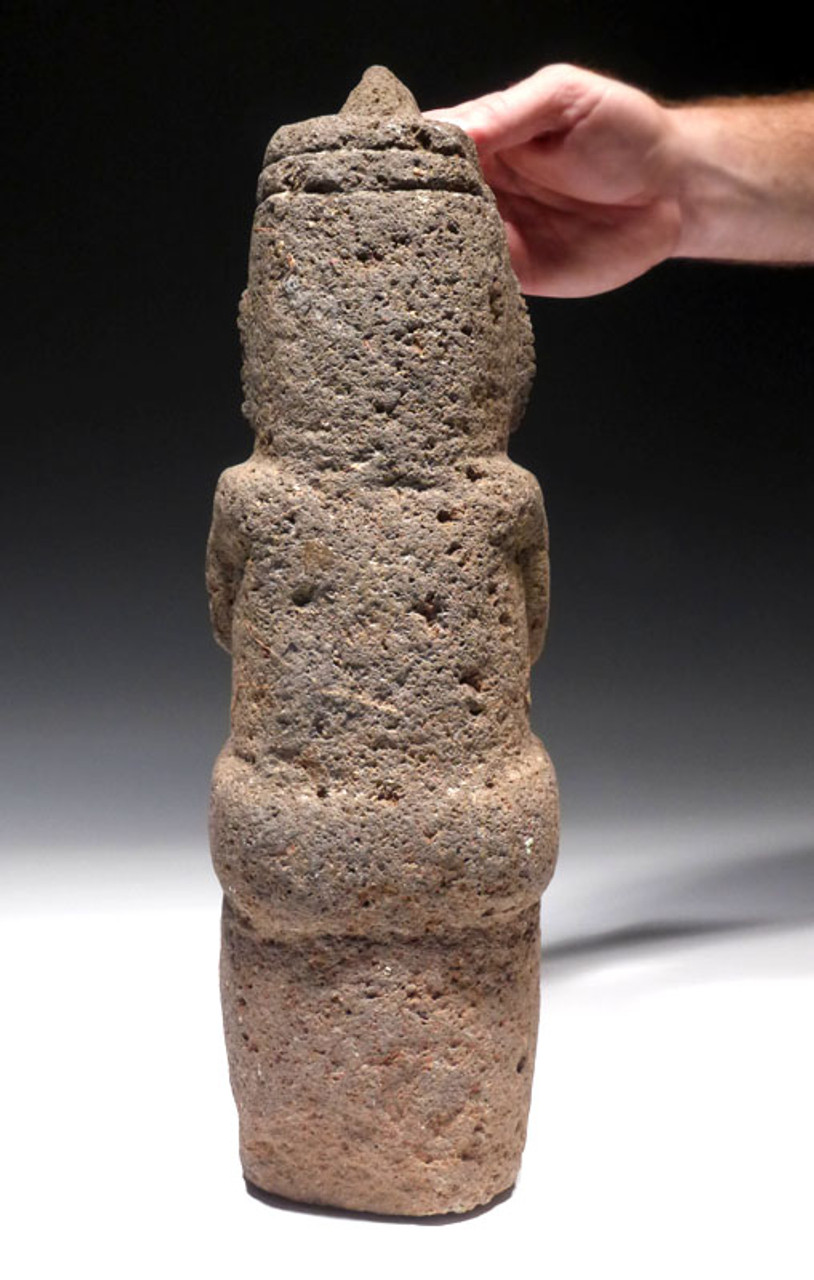Product Description
ITEM #
|
PC098
|
||
ID
|
Stone Figure
|
||
FOUND
|
Atlantic Watershed - Central America
|
||
AGE
|
Period IV: 300 B.C. - 500 A.D.
|
||
SIZE
|
18" tall x 6" wide
|
||
CONDITION
|
INTACT AND COMPLETE. NO REPAIR OR
|
||
NOTE
|
CARVED STONE PRE-COLUMBIAN PORTABLE ART
|
||
Actual Item - One Only
Comes with a certificate of authenticity / information sheet |
|||
This MUSEUM-CLASS example of the shaman in action, is one of the largest portable Pre-Columbian carved stone pieces we have ever seen. It can be attributed to the Greater Nicoya Pre-Columbian culture of Central America and is massive, towering 18" in height. It depicts a seated shaman with eyes closed and lips pursed as if singing or making some sort of sound. The hands are drawn up to his chest as if paralyzed in an altered state. He is wearing a cone shaped cap on his head and seated on a cylindrical stool, being part of the base of this single block of stone. The entire figure was hand-carved out of a single massive piece of volcanic stone and remarkably, has remained INTACT, UNBROKEN AND UNDAMAGED! Originally collected in the 1950's by the original owner, you can still see the traces of mineralized embedded roots on the surface in various areas. Additional impacted sediment in the porous stone is proof of the authenticity and age of this piece. Slight loss to the nose but otherwise, this AMAZING volcanic stone carved statue is PERFECT as it was originally made. A TRUE INVESTMENT-GRADE MUSEUM EXAMPLE that offers an extremely rare opportunity for a collector to add an important, monumental specimen to their collection.
Shamanism played a core role in everyday life of Pre-Columbian tribes in Central America. The role of the shaman involved attaining altered states of consciousness in order to encounter and interact with the spirit world and channel these transcendental energies into this world. The purpose was for a variety of ritual practices and to have access and influence to benevolent and malevolent spirits in the mystical world. Shamans would typically enter trances to connect with this world and communicate with these spiritual forces for a variety of reasons including healing, divination and to cast or break spells. The role of the shaman was highly revered as they were believed to control forces beyond the reach of mortal men and women. Shamans would ingest fermented drinks as well as naturally occurring narcotics such as coca and hallucinogenic mushrooms to induce a trance-like state of mind.
The Greater Nicoya Pre-Columbian Culture is an archaeological culture that prevailed in the area of Latin America comprising the far southwestern coastal region of Honduras, the far northwestern Pacific coastal region of Costa Rica and the Pacific side of coastal Nicaragua. This indigenous Indian culture thrived for many centuries before the first Spanish explorers made contact around 1500 A.D.. The people had no written language but spoke Nahuatl and had continual contact with the Aztec (Mexica) Indians of Central Mexico. The Gran Nicoya culture included many beautiful designs incorporating a variety of different mammals, reptiles and amphibians in effigy pieces. Their pottery is also known for complex glyph-like painted decorations. In the first 500 to 600 years A.D., resources became low as populations grew and warfare become increasingly evident. Tribes in this region practiced head-hunting and victim sacrifice in their warfare.
 US DOLLAR
US DOLLAR
 EURO
EURO
 AUSTRALIAN DOLLAR
AUSTRALIAN DOLLAR
 CANADIAN DOLLAR
CANADIAN DOLLAR
 POUND STERLING
POUND STERLING
























